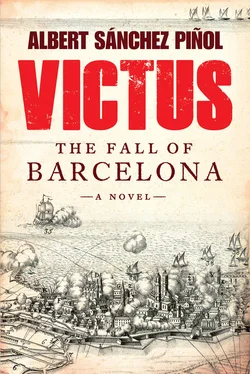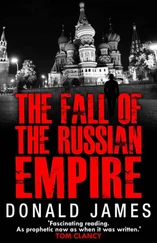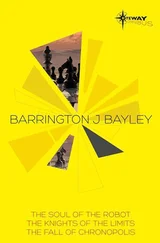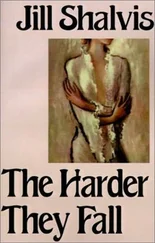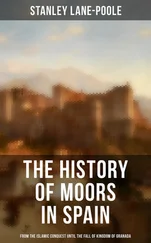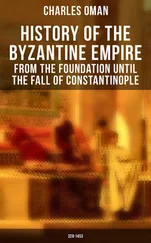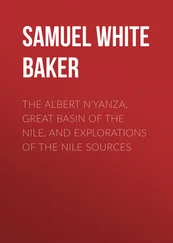“Do you believe in premonitions?” he asked me.
“No,” I said.
“I do. If Barcelona doesn’t surrender, and we embark on the full assault, it will be the death of me. I know it.”
Saying this, he turned his gaze back to the fire.
The trench was begun on July 11, 1714, in the night.
Jimmy was well stocked on all counts: The first parallel had thirty-five hundred men to dig it, and these received cover from ten infantry battalions and ten companies of grenadiers. Accustomed to war being waged on a shoestring, I couldn’t but envy such fabulous resources.
My French captain’s uniform made it easy for me to infiltrate myself into the trench. No sooner had the digging begun than I hopped in. And how hard they worked! Thousands of spades, in a line over half a mile long, flinging earth forward, toiling as hard as galley slaves.
The furrow went from knee-deep to chest-deep in a small space of time. Thousands of the fajina baskets were being circulated around. These they would line with stones and sand and then place on the front edge of the trench, followed by further reinforcing shovelfuls of earth. I despaired over the Coronela’s inaction — What are you waiting for? I thought. Attack, you ought to have attacked already!
You can usually bank on a counter-assault the first day a trench begins. The men working, and the troops providing covering fire, are very exposed. The most common maneuver consists of an artillery bombardment followed by large numbers of men carrying out a lightning sortie. If they plan properly and have fortune on their side, the besieged troops will overrun the men covering the trench; the parallel is not very deep yet and doesn’t provide much shelter. The idea of this first sortie is to ruin the works, even fill in what’s been dug, then immediately fall back. It doesn’t seem like much, but in war, morale is crucial. The city sends the attacking army a message: “What you’ve done is undone. Come and get us!” The works have to start all over again.
The Bourbons were vulnerable, as is the case on the first day of any siege. But my redesign of Verboom’s trench also meant that they’d be beginning particularly close to the ramparts. An unusually short distance, truly. Only two thousand feet, which was one and a half times the distance a rifle could shoot. My secret hope — which, naturally, I didn’t communicate to Verboom — was that a general as attentive as Don Antonio would notice the works and attack. Everything would play in our favor. With this first parallel so close to the ramparts, our lads would be able to tackle the trench in an instantaneous charge. If they charged quickly, they’d have no losses until arm-to-arm combat began, and then their zeal would surely be far greater than that of the Beast’s French mercenaries or Little Philip’s Spanish recruits.
Jimmy gave the order for drums to be played throughout the night, a standard procedure to drown out the sound of the men at work. A waste of time. Even if the works begin in the middle of the night, several thousand men digging are impossible to hide. The next morning is the worst for the sappers: Following a long night’s work, they’re exhausted, and as the sun comes up, they relax — nothing’s happened yet. That’s when a lightning attack comes from the besieged army.
But on this occasion, the sun was already up, and there was no sign of any activity on the city walls. Why didn’t the Barcelonans attack, why? I broke down inside: Don’t you see? I said to myself. Sweet Jesus, attack! And then I experienced the most atrocious feeling, one I’d never wish on another living soul. “My God,” I said, “maybe you designed it too well, Martí!”
Of course Don Antonio was planning a lightning attack on the trench the moment it began — which I, not being inside the city, naturally had no way of knowing. So what was going on? The Red Pelts — for a change — had stuck their oars in. Don Antonio spent the night of the twelfth preparing the sortie, and the very first thing on the thirteenth, he sent word to his wife up on Mount Montjuic that he would come to her at nine in the morning and they would later take lunch together. The letter was dictated publicly, so that at eight in the morning the whole city knew that, instead of attacking, General Villarroel was going to spend the entire day dining sumptuously. A truly Homeric snub to the enemy! “They begin their trench? In that case, I shall fill my belly. See how little I care for what they do or do not do!”
Even my dear vile Waltraud can tell that the letter was meant to throw the Bourbon spies off the scent. As we know, there were more spies swarming around the city at that time than flies on a donkey’s behind. At nine in the morning, Don Antonio did indeed go up to Montjuic surrounded by a large and visible escort. But his plan was to slip back at eleven, a long while before anyone in the Mediterranean would ever sit down to lunch, and then lead the attack.
Among the ministers, Casanova had been beside himself since the moment he’d received word that the Bourbons had begun their trench. Coming across one of our infantry generals, he lost his temper. “Seeing as you’re going to Villarroel’s little party in Montjuic,” he cried, “you can tell him that the people won’t take it all well, not at all well, that the enemy is being allowed to go about its work so freely!”
This general, of course, passed the message on. Appalled at the dressing-down he’d been given, he made out that the conseller en cap ’s words had been even more injurious. There was nothing Don Antonio could do but defer the attack to go and conciliate the ministers. Not satisfied with having ruined the ploy, Casanova hardly calmed down even when he was made to understand what the plan had been. To top it off, he held forth on what he thought the approach should be for the sortie. I still think that no one in besieged Barcelona quite understood to what point a military man like Don Antonio had his patience tested. There were a hundred more darts on the part of Casanova, not one of which is worth recounting.
As Casanova and Don Antonio argued, I was huddled in the first parallel, sheltering as best I could from the cannonade raining down from our parsley-chewing artillery chief, Francesc Costa.
Costa, ever his own man, hadn’t waited for any orders to begin firing. Before the sun was up, he’d relocated eight mortars and forty-eight cannons, which then began hurling cannonballs and grapeshot down on the first parallel and my poor head.
If artillery were an art, that dawn bombardment would go down as immortal. The missiles curved perfectly through the air. Smoke trails marked their flight. Some of the shells weighed over a hundred pounds. They flattened everything and raised immense fountains of earth wherever they fell, fajinas in pieces, wicker baskets ejected like cutlery.
Costa’s Mallorcans alternated stone shells with fused explosive ones — when the latter were two or three meters above the ground, they’d burst open in a flash of white and yellow, spilling red-hot shards onto the heads of everyone in the trench. It was no easy thing to make the fuse exactly the correct length so that it would blow just as it came over the trench, not a moment sooner; too high and the grapeshot wouldn’t cause as much damage, too late — once the shell had landed — and the ground would absorb the explosion. If you’re facing someone with Costa’s skills, the only hope is to dig your trench deep and not too wide, thereby reducing the lethal area. But if you remember, I had convinced Verboom to do the opposite, with very wide and shallow trenches.
As you know, though, I wasn’t with our artillery but behind the Bourbon lines. Which twist of fate meant I was on the receiving end of Costa’s artistic talents, the cannonballs whooshing and exploding above me. I remember the smell of the warm, wet earth in the trenches, and its still-to-be-braced walls. All around me — crammed beneath and on top of me — dozens of workers were sheltering, as I was, cowering and whimpering in fear of the aerial detonations. The sheer chaos of an Attack Trench means that any survivor has an extreme tale to tell. It is a three-dimensional fight for your life: on the ground, using your hands, in the air, with the bombs; and under the ground, with the mines. Add to that a fourth: You are fighting against time. The advance of a trench is the world’s most quantifiable truth. Even so, that’s the case only in terms of le Mystère or from the perspective of a Ten Points. To the engineer on the side of the besieging army, the advance will always seem to go at a snail’s pace; to the one inside the city, faster than a running deer. An Attack Trench is both the most precise human endeavor and that which must take place under the most savage conditions.
Читать дальше
